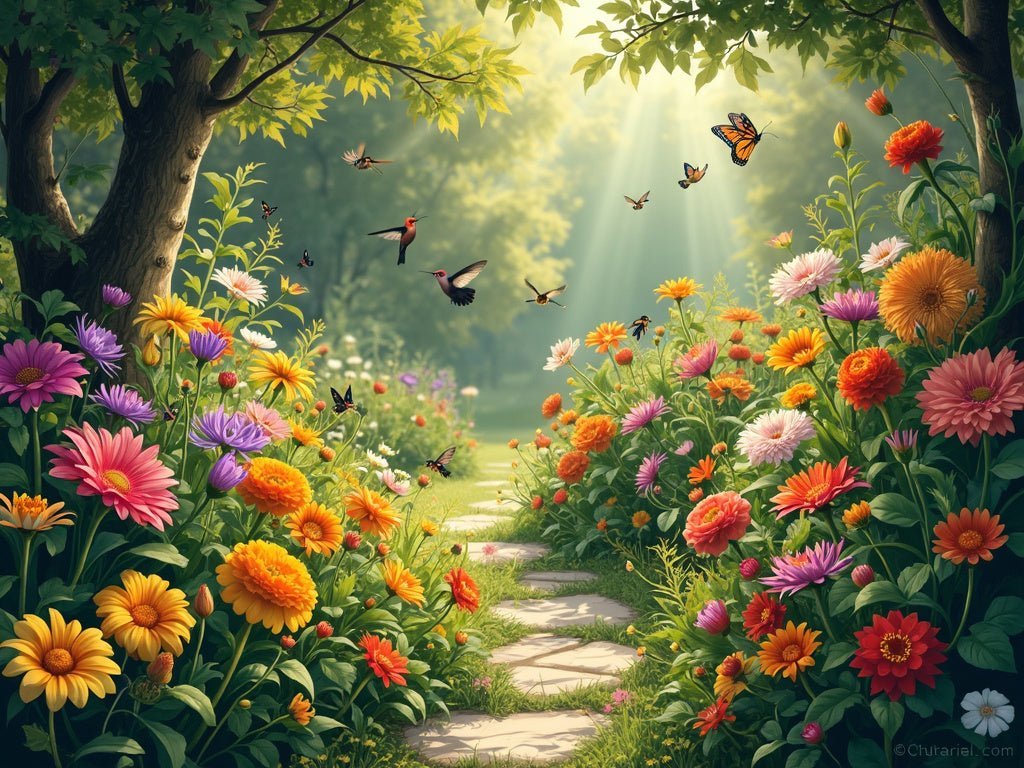
Transform Your Garden into a Pollinator Paradise: Simple Steps to Create Your Own Enchanting Wildlife Sanctuary
|
|
Time to read 5 min
|
|
Time to read 5 min
Table of contents
Native plants are the backbone of a healthy ecosystem. They've evolved alongside local wildlife, providing the perfect food and shelter for a variety of species. By incorporating these plants into your garden, you're not just creating a pretty space – you're building a thriving habitat.
This quote perfectly captures why educating ourselves about native plants is so crucial. The more we understand their importance, the more likely we are to protect and nurture them.






Pollinators are the unsung heroes of our ecosystems. Bees, butterflies, and hummingbirds play a vital role in plant reproduction and food production. Here's how to roll out the red carpet for these VIP guests:
Remember, variety is key. Different pollinators prefer different flower shapes and colors. Mix it up to attract a diverse crowd.
Pesticides might seem like a quick fix, but they're doing more harm than good. They don't just kill pests – they wipe out beneficial insects too. Instead, try these natural alternatives:
By going pesticide-free, you're creating a safer environment for all creatures, big and small.
Solitary bees and other beneficial insects need safe places to lay their eggs and protect their young. Creating insect hotels is an easy and fun way to support these tiny helpers. You can even make it a family project!
DIY Insect Hotel Tips:
For more eco-friendly gardening ideas using bamboo, check out our bamboo cutting board guide. Bamboo isn't just for the kitchen – it's great for garden projects too!
Hummingbirds are a joy to watch and great pollinators. To attract these flying jewels:
Remember, once you start feeding hummingbirds, keep it up. They rely on these food sources during migration.
Wildflower meadows are a game-changer or wildlife and lazy gardeners alike. They're low-maintenance, drought-resistant, and absolutely stunning. Here's how to get started:
Once your meadow is thriving, you'll only need to mow it once a year. Talk about easy care!
Sustainability isn't just a buzzword – it's crucial for creating a garden that thrives year after year. Here are some tips to keep your wildlife haven going strong:
For more sustainable gardening ideas, including using bamboo in your garden projects, check out our guide on eco-friendly attributes of bamboo.
Pollinator pathways are like highways for bees and butterflies. By planting native flowers and shrubs in a continuous line, you're creating a safe travel route for these important creatures. Here's how to get started:
Remember, even small spaces can make a big difference. A window box or patio container can be part of a pollinator pathway.
Monarch butterflies are facing serious challenges, but you can help by creating a Monarch Waystation. This special garden provides everything monarchs need to breed and fuel up for migration. Key components include:
Registering your waystation with Monarch Watch helps track these efforts nationwide.
Bamboo isn't just for pandas – it's a versatile, sustainable material that can enhance your wildlife garden. Here's how:
For more on bamboo's eco-friendly qualities, check out our article on why bamboo is great.
Q: How long does it take for a wildlife garden to attract animals?
A: You might see results within a few weeks, but it can take a full growing season for your garden to really establish and attract a variety of wildlife.
Q: Can I create a wildlife garden in a small space?
A: Absolutely! Even a balcony or small patio can become a mini wildlife haven with the right plants and features.
Q: How do I balance a wildlife-friendly garden with a tidy appearance?
A: Focus on natural-looking designs, use native plants in organized beds, and maintain clear pathways. Remember, a bit of "wildness" is good for wildlife!
Creating a wildlife haven isn't just about having a pretty garden – it's about being part of something bigger. Every native plant you grow, every pollinator you support, contributes to the health of our planet.
So, roll up your sleeves, get your hands dirty, and start creating your own little piece of paradise. Your local wildlife (and the planet) will thank you.
Remember, the journey to a thriving wildlife garden starts with a single native plant. What will you plant first?
Shop our eco-friendly gardening tools to get started on your wildlife haven today!